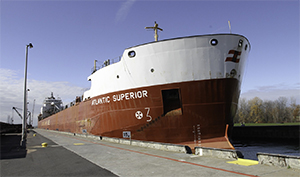Would it make sense to privatize the St. Lawrence Seaway?
That’s the question that President Trump’s fiscal 2019 budget poses. It is part of the administration’s push to privatize federal infrastructure, but it has some Seaway port operators concerned.
The president’s Department of Transportation (DOT) fiscal 2019 budget proposal, released in February, said a study will be finished in fiscal 2018 “to examine the feasibility of privatizing or commercializing U.S. Seaway operations currently managed by the (Saint Lawrence Seaway Development Corp.),” the federal agency that runs the American side of the Seaway.
“We don’t like the precedent of this, we don’t like where it is heading,” said Steven Fisher, executive director of the American Great Lakes Ports Association. “It raises the question of what else will be privatized in the future.”
Fisher said his fear is that a private company would bring back tolls to the American side of the Seaway, levies that were matched with federal rebates in 1986 and eliminated in 1994. “We had done away with tolls,” he said. “In our mind, the U.S. did the exact perfect thing. Why step backward?”
Reinstituting tolls would be a disadvantage for the Great Lakes-Seaway System as it competes with other ports and modes of transportation. The Seaway’s competitors include East Coast and Gulf of Mexico ports, rail transport and trucking.
“If the administration is going to talk about any portion of a competitive landscape being privatized, you have to do it for everybody,” Fisher said. By privatizing one sector, “you are skewing trade … by forcing people to pay user fees that are not otherwise there.” In February, Trump also proposed privatizing the 12,000-mile inland waterway system.
Federal subsidies for waterways transportation lag well behind other modes. A 2011 Government Accountability Office (GAO) report on freight transportation showed that trucking gets the most in subsidies, followed by rail and then waterways shipping, said William Friedman, chief executive officer of the Port of Cleveland.
Trump’s budget proposal also refers to Canada’s commercialization of the Seaway, which occurred in 1998, as a model for the DOT study. But Fisher said that comparison is not accurate since Canada’s St. Lawrence Seaway Management Corp. is a nonprofit entity.
The Canadian side of the Seaway was being run inefficiently by a government agency, he said. When Canada commercialized the Seaway, “they didn’t just privatize it, they effectively gave it to the users to manage it — they didn’t call in some large infrastructure management company,” Fisher said. “This is a different idea than what the Trump administration is proposing.”
While port operators are leery of the study, a potential Seaway customer believes it could be a good move. Jeff Kamerer, senior supply-chain logistic planning analyst for The Timken Company, said that keeping the Seaway open year-round would mean his company would be more likely to use the system. A commercialization study could consider that change, which would make the Seaway a more appealing shipping option, he said.
The Seaway is closed, on average, from late December to late March. Kamerer said he plans shipping routes a year ahead of time. “Once you get into the winter season and have to divert to another port, it makes it more costly and more burdensome to make changes,” he said.
Timken, based in North Canton, Ohio, makes engineered bearings and power transmission products. It also repairs and rebuilds industrial components. Its headquarters is 50 miles from the Port of Cleveland.
Right now its products are trucked to Columbus, Ohio, then put on rail cars and transported to Norfolk International Terminals in Virginia for shipment to customers around the world. With the increase in trucking costs and a shortage of trucks, “I am interested in looking at Cleveland (for shipping),” said Kamerer. “It makes a lot of sense to go from Canton to Cleveland.”
Norfolk handles mostly container cargo, with limited break-bulk shipping that is used primarily for high-end items such as automobiles, he said. Cleveland offers break-bulk shipping that is better for Timken’s products, which are mostly large pieces of steel. Only about two pieces fit into a container, and it costs a lot to load and unload the steel, he said.

